mybatis
基本使用
整合springboot
1.添加依赖
2.添加配置
spring:
# 数据源相关配置
datasource:
username: root
password: 123456
driver-class-name: com.mysql.cj.jdbc.Driver
#时区必须配置否则报错,注意数据库名切换为自己的数据库名称
url: jdbc:mysql://127.0.0.1/itheima?useUnicode=true&characterEncoding=UTF-8&serverTimezone=UTC
#mybatis 相关配置
mybatis:
# 指定接口映射文件的位置
mapper-locations: classpath:mapper/*.xml
# 为POJO类指定别名 指定后使用时不再需要指定包名
type-aliases-package: com.itheima.integration.pojo
# 开启debug日志
logging:
level:
com.itheima.springbootinit4: debug
3.指定DAO接口所在的包
@SpringBootApplication
@MapperScan("com.winter.dao")
public class SpringbootMybatisDemoApplication {
public static void main(String[] args) {
SpringApplication.run(SpringbootMybatisDemoApplication.class, args);
}
}
模糊查询

获取自增主键
插入数据后获取自增主键的方案有两种,分别是使用<selectKey>和useGeneratedKeys属性
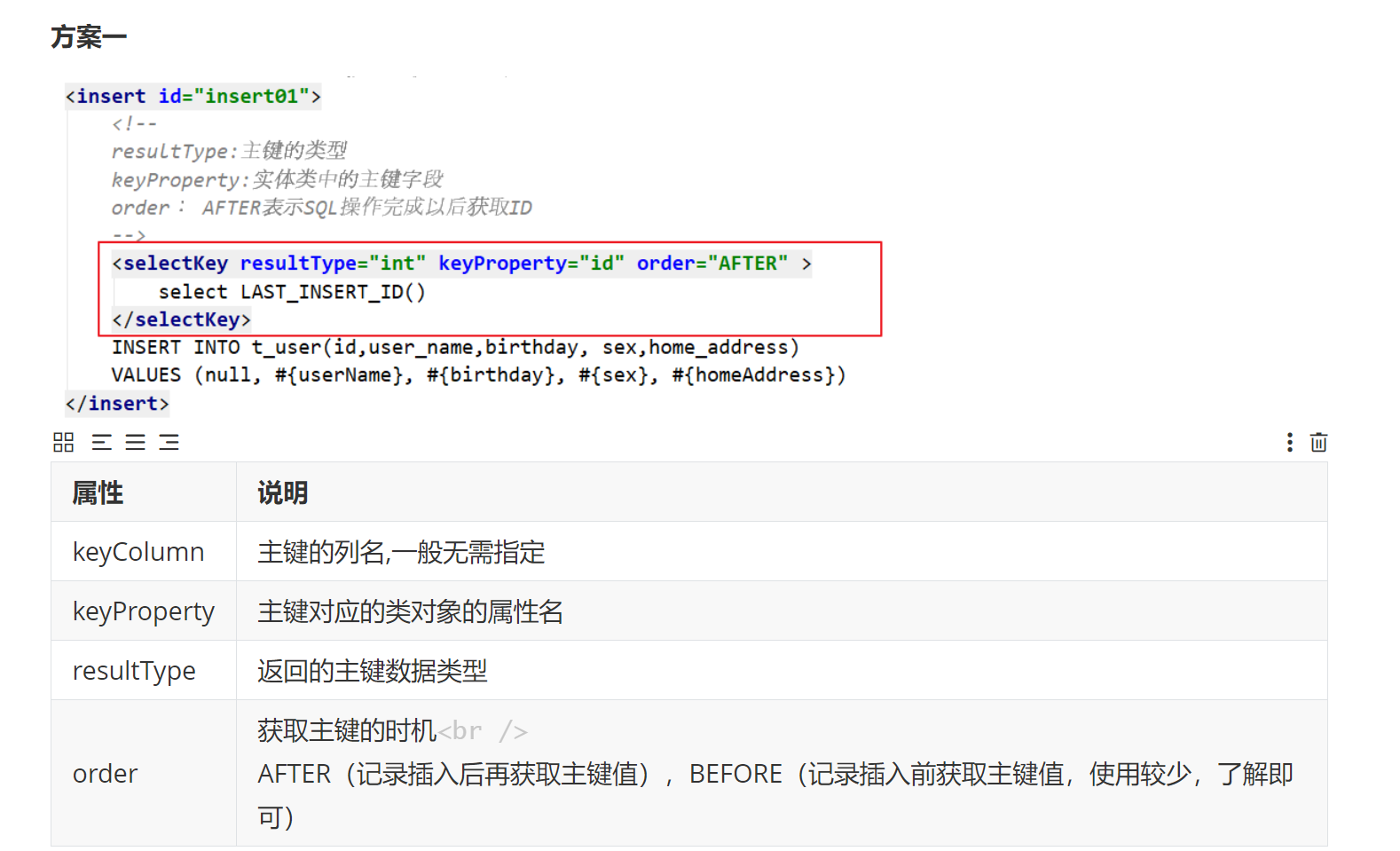
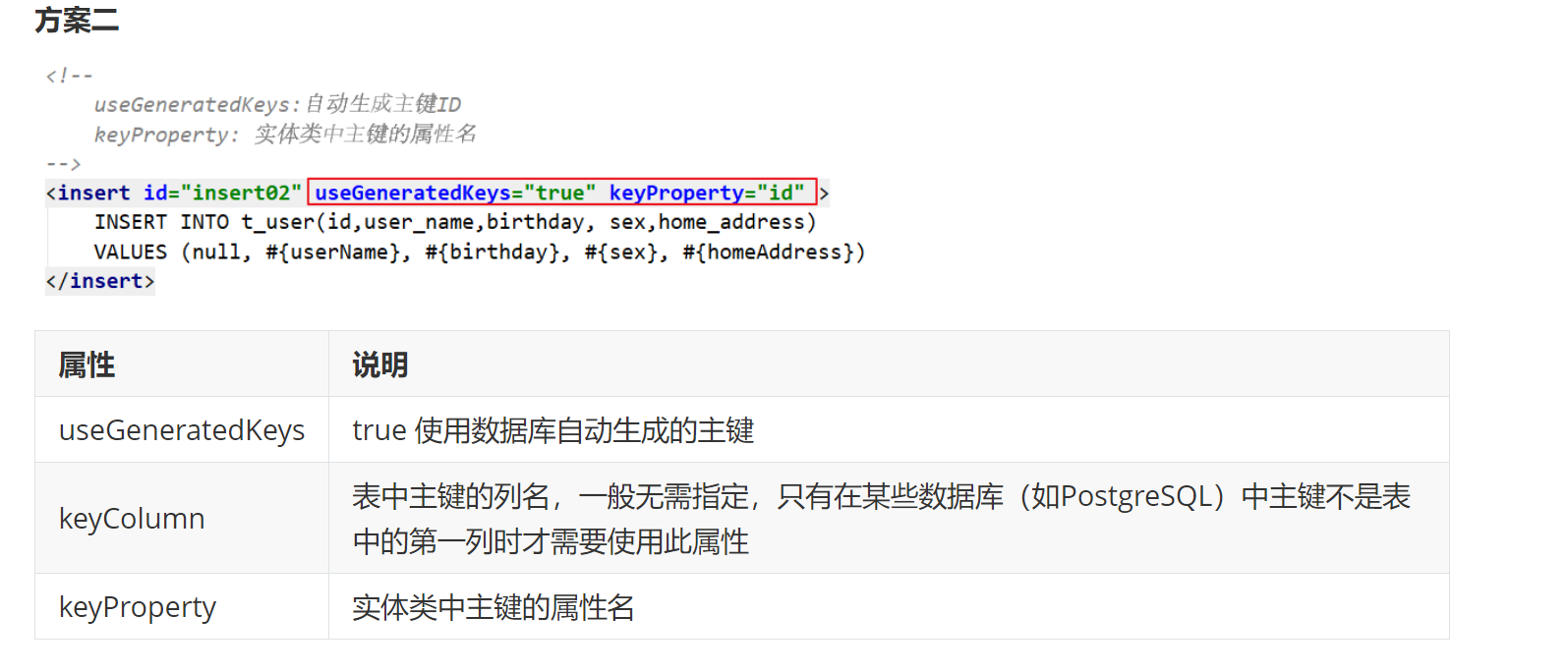
扩展 如果id为字符串类型,主键由uuid生成

ognl 表达式
#{} 【推荐】: 占位符, 相当于PreparedStatement对象, 会自动转换类型
pojo对象 #{对象中的属性名} -- 获取pojo中的属性
基本数据类型 #{参数名} -- 获取基本类型数据,参数名通过@Param("xxxx")指定
${} : 拼接符, 相当于字符串直接拼接, 不会自动转换类型,需要手动拼接类型
pojo对象 ${对象中的属性名} -- 获取pojo中的属性
基本数据类型 ${参数名} -- 获取基本类型数据,参数名通过@Param("xxxx")指定
User selectById( @Param("id") Integer id);
<!--
属性
id 对应方法名,唯一
parameterType 参数的类型,可以省略
resultType 返回值类型
-->
<select id="selectById" parameterType="java.lang.Integer" resultType="com.itheima.entity.User">
select * from t_user where id = #{id}
</select>
<!--
获取mapper传入参数
1.简单类型:四类八种, String 获取:使用`#{}`直接获取参数,名称可以任意写(有注解时与注解保一致)
2.实体对象参数(POJO类)
获取:使用`#{}`直接获取对象的属性(有注解时,注解内容 点 属性)
-->
标签
resultMap 标签
<!--
定义映射
id:映射的名字
type:实体类
-->
<resultMap id="userResultMap" type="User">
<!--
定义字段映射,id和result标签分别表示主键字段映射和非主键字段映射
property 实体类中的属性名
column SQL返回结果的列名
如果property和cloumn的值相同,可以省略
-->
<id property="id" column="id"/>
<result property="userName" column="user_name"/>
<result property="birthday" column="birthday"/>
<result property="sex" column="sex"/>
<result property="homeAddress" column="home_address"/>
</resultMap>

where 与 if 标签
<!--
where:
1. where标签就相当于SQL语句中where关键字
2. 去掉多余的and、or关键字
if:
判断条件是否为真,如果为真则将if中字符串拼接到SQL语句中
-->
<select id="selectByUserNameAndSex" resultMap="userResultMap">
select * from t_user
<where>
<if test="userName!=null and userName!=''">
user_name=#{userName}
</if>
<if test="sex!=null and sex!=''">
and sex=#{sex}
</if>
</where>
</select>
set 标签
<!--
set
1.一般与if标签配合使用
2.set用在update语句中,相当于set关键字
3.会自动去掉能多余的逗号
-->
<update id="updateByIdSelective">
update t_user
<set>
<if test="userName!=null">
user_name = #{userName},
</if>
<if test="birthday!=null">
birthday = #{birthday},
</if>
<if test="sex!=null">
sex = #{sex},
</if>
<if test="homeAddress!=null">
home_address = #{homeAddress},
</if>
</set>
where id=#{id}
</update>
foreach 标签
<insert id="insertRecords">
insert into t_user values
<foreach collection="users" item="user" separator=",">
(#{user.id}, #{user.userName}, #{user.birthday}, #{user.sex}, #{user.homeAddress})
</foreach>
</insert>
<delete id="deleteByIdS">
delete from t_user where id in
<!--
open 遍历开始前添加的符号
close 遍历完成后添加的符号
-->
<foreach collection="ids" item="id" separator="," open="(" close=")">
#{id}
</foreach>
</delete>
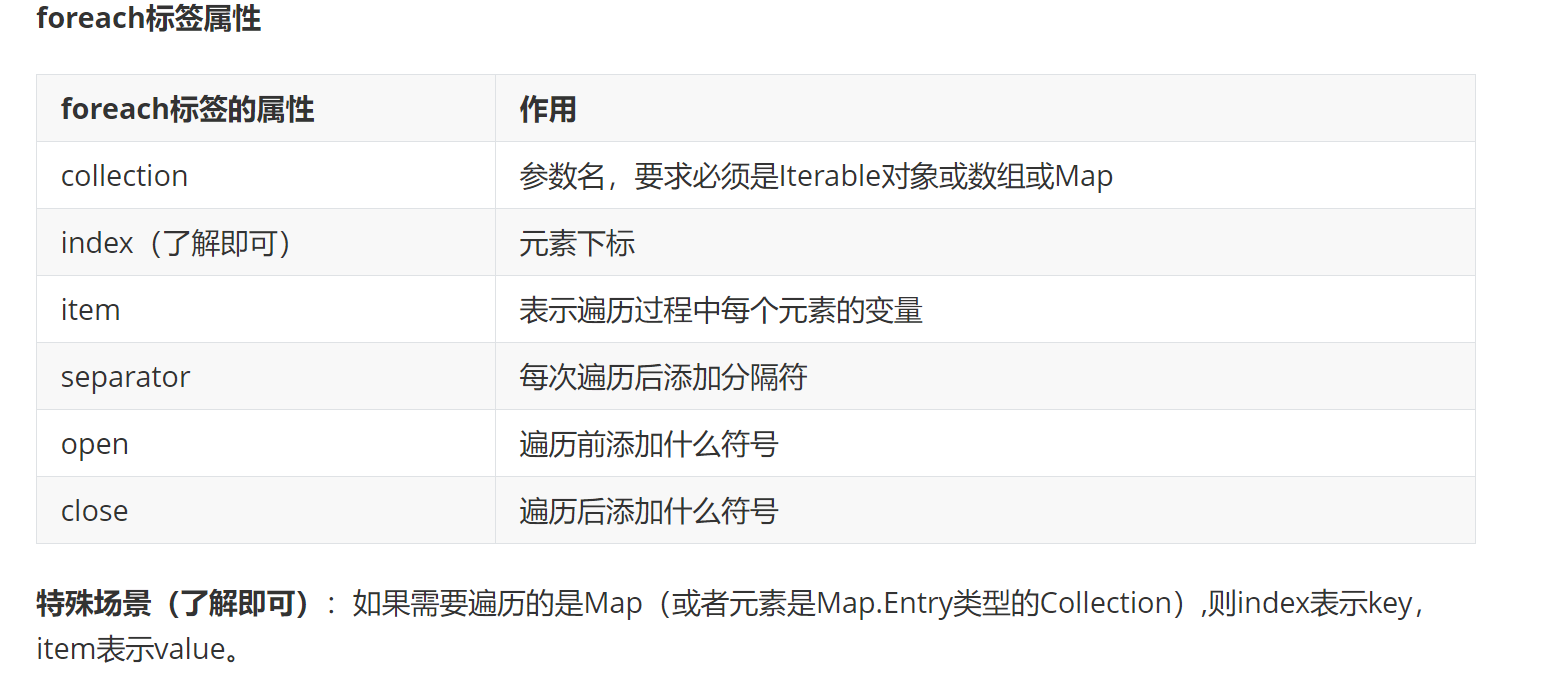
sql/include标签
- sql标签:定义一段可以重用的SQL语句
- include标签:refid 关联sql标签的id
<!--定义可重用的代码块-->
<sql id="conditionSql">
<if test="condition!=null and condition!=''">
where user_name like concat('%',#{condition},'%')
or home_address like concat('%',#{condition},'%')
</if>
</sql>
<!--根据条件查询-->
<select id="selectByConditon" resultMap="userResultMap">
select * from t_user
<!--引用代码块-->
<include refid="conditionSql"/>
</select>
<!--根据条件统计-->
<select id="countByConditon" resultType="int">
select count(1) from t_user
<!--引用代码块-->
<include refid="conditionSql"/>
</select>
结果集复杂映射
当SQL查询的结果集复杂,不能(或不方便)使用一个类结构来接收这些数据,我们就称这种映射是复杂映射。复杂映射一般分为两种:一对一、一对多。
一对一映射通过<assosication>标签实现;一对多映射通过<collection>标签实现。
一对一映射
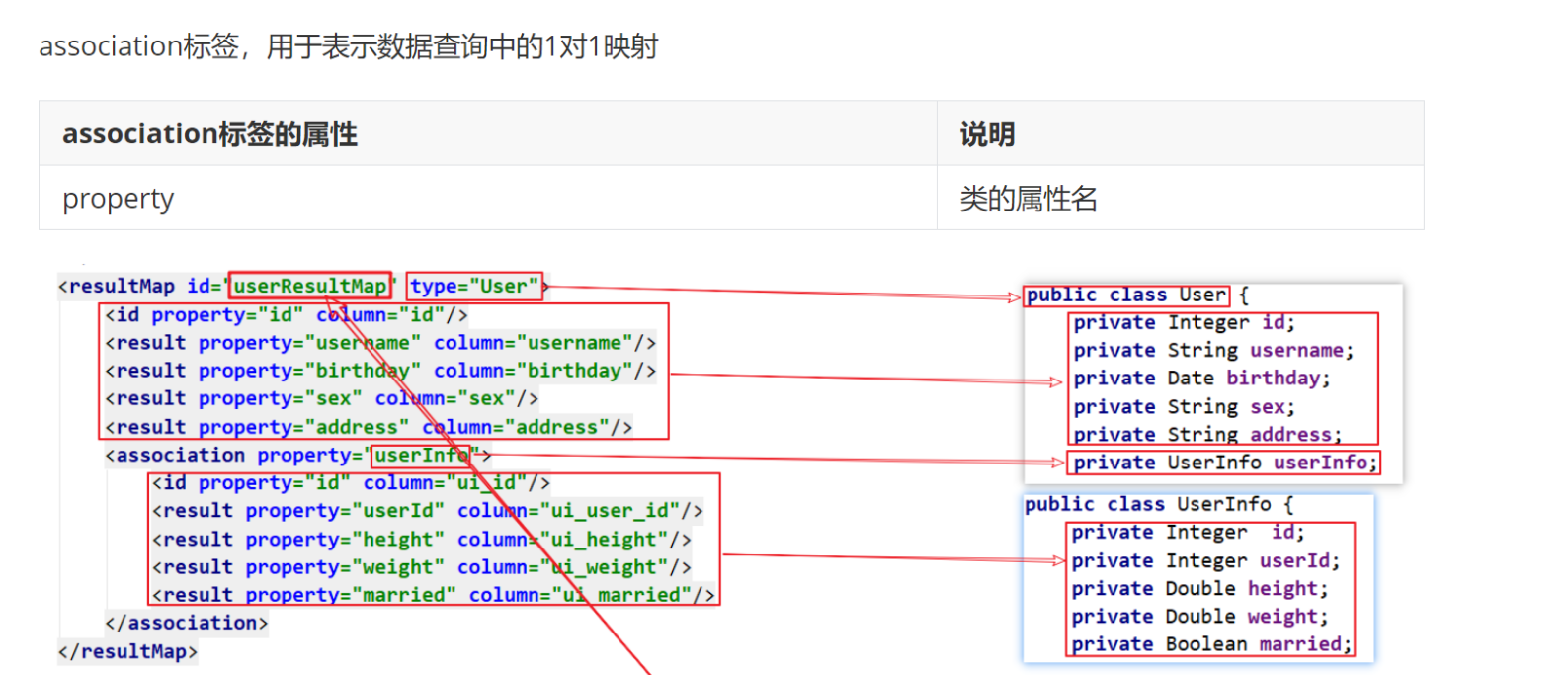

一对多
<!--
一对多映射
1. collection标签,用于表示数据查询中的1对多映射
2. 此时,resultMap和collection都需要指定所有字段的映射,不能省略(同association)
3. SQL查询的结果集中不能有重复的字段,如果有重复字段,则映射过程中只有第一个字段可以取到正确的值,所以需要给名称重复的字段使用别名。(同association)
-->
<resultMap id="userAndOrderResultMap" type="User">
<id property="id" column="id"/>
<result property="username" column="username"/>
<result property="birthday" column="birthday"/>
<result property="sex" column="sex"/>
<result property="address" column="address"/>
<!--
collection 映射成一个集合
porperty 类属的属性名
ofType 集合内元素的类型
-->
<collection property="orders" ofType="Order" >
<id property="id" column="o_id"/>
<result property="userId" column="o_user_id"/>
<result property="goods" column="o_goods"/>
<result property="createTime" column="o_create_time"/>
<result property="note" column="o_note"/>
</collection>
</resultMap>
<select id="selectUserAndOrderById" resultMap="userAndOrderResultMap">
SELECT tu.*,
tor.id o_id,
tor.user_id o_user_id,
tor.goods o_goods,
tor.create_time o_create_time,
tor.note o_note
FROM t_user tu join t_order tor on tu.id=tor.user_id
where tu.id=#{id}
</select>
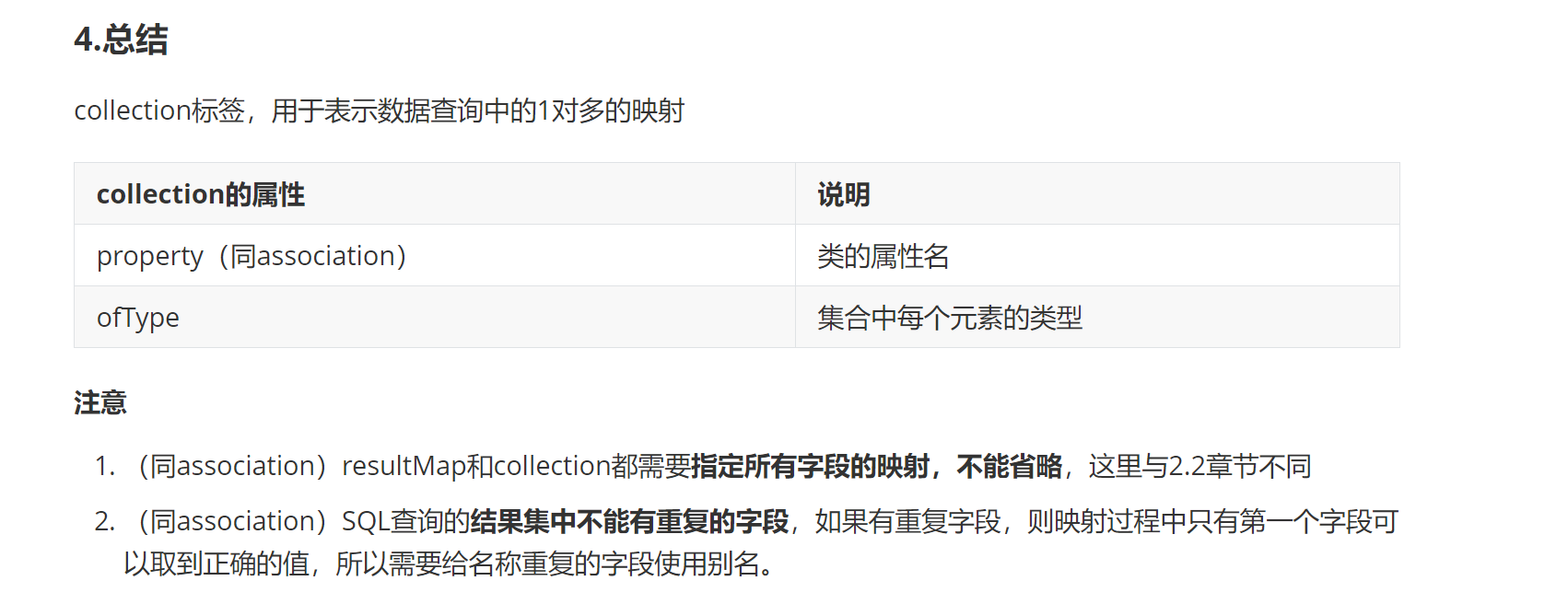
级联(嵌套)查询

public interface UserMapper{
/**
* 查询所有用户基本信息、拓展细信、订单
*
* @return
*/
List<User> selectAllUserAndInfoAndOrder();
}
<!--用户详细信映射-->
<resultMap id="userDetailResultMap" type="User">
<id property="id" column="id"/>
<result property="username" column="username"/>
<result property="birthday" column="birthday"/>
<result property="sex" column="sex"/>
<result property="address" column="address"/>
<!--
association和collection都可以通过column属性和select属性配合完成级联查询操作
select 子查询,一个select标签的id
column 指定参数传递
-->
<association property="userInfo" column="id" select="selectUserInfoByUserId"/>
<collection property="orders" column="id" select="selectOrderByUserId"/>
</resultMap>
<!--用户拓展信息映射-->
<resultMap id="userInfoResultMap" type="UserInfo">
<result property="userId" column="user_id"/>
</resultMap>
<!--订单信息映射-->
<resultMap id="orderResultMap" type="Order">
<result property="userId" column="user_id"/>
<result property="createTime" column="create_time"/>
</resultMap>
<!--查询用户信息-->
<select id="selectAllUserAndInfoAndOrder" resultMap="userDetailResultMap">
select * from t_user
</select>
<!--查询用户拓展信-->
<select id="selectUserInfoByUserId" resultMap="userInfoResultMap">
select * from t_user_info where user_id=#{userId}
</select>
<!--查询订单信-->
<select id="selectOrderByUserId" resultMap="orderResultMap">
select * from t_order where user_id=#{userId}
</select>
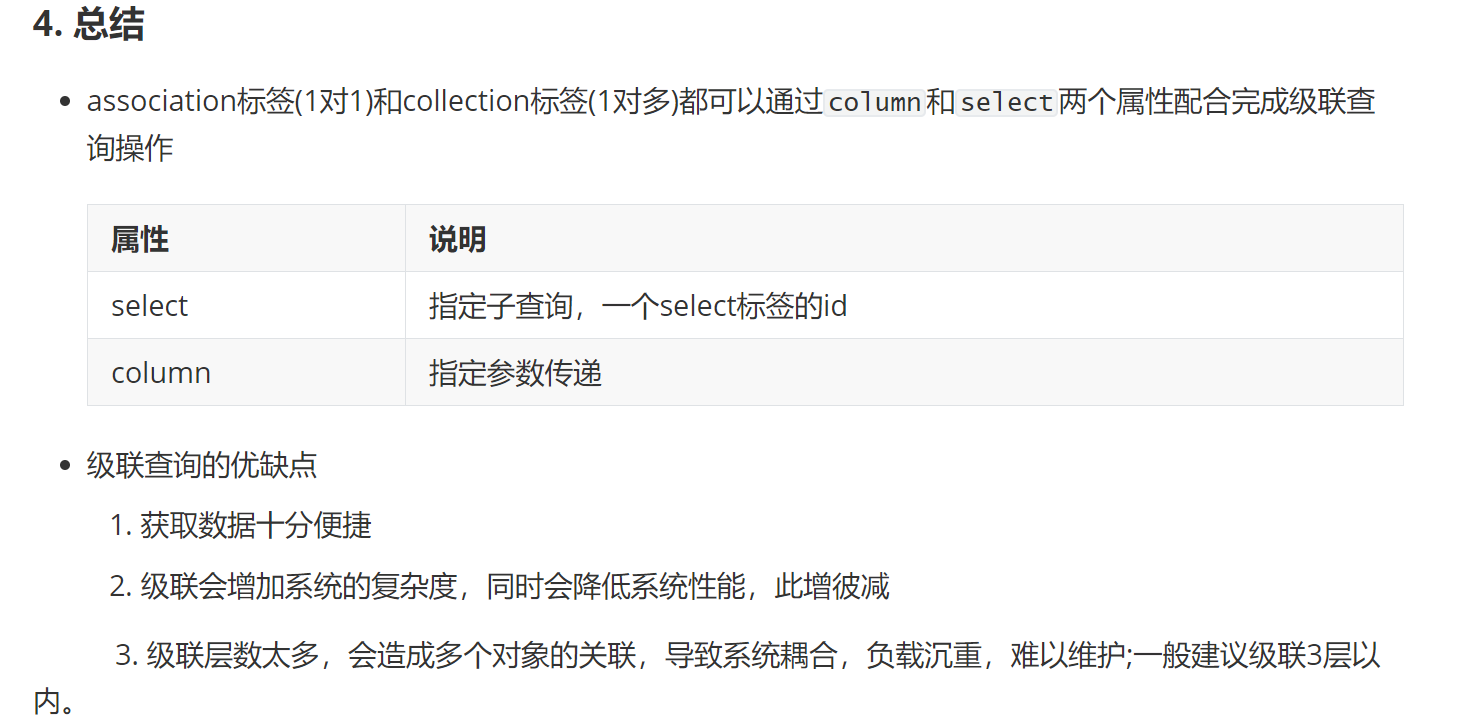
自动映射
当自动映射查询结果时,MyBatis 会获取结果(sql查询结果集)中返回的列名并在 Java 类中查找相同名字的属性(忽略大小写)。 这意味着如果发现了 ID 列和 id 属性,MyBatis 会将列 ID 的值赋给 id 属性。
通常数据库列使用大写字母组成的单词命名,单词间用下划线分隔;而 Java 属性一般遵循驼峰命名法约定。

注解开发
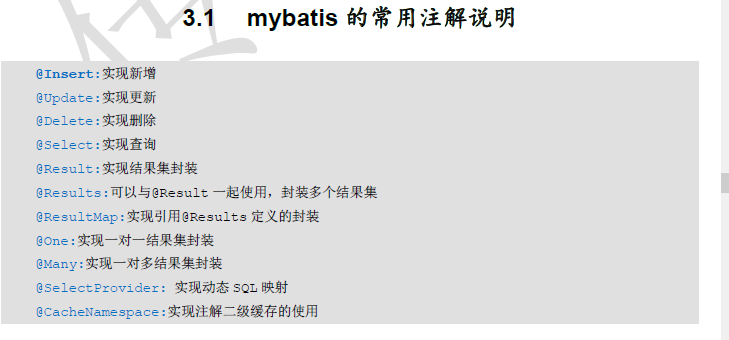
增删改查注解
@Select(“查询语句”)查询;
@Update(“更新语句”)更新;
@Delete(“删除语句”)删除;
@Insert(“插入语句”)插入;
@SelectKey()
public interface UserMapper {
@Select(value = "select * from t_user where username like concat('%',#{username},'%')")
List<User> selectByLike(String username);
/**
* 分页查询
* @param startIndex
* @param pageSize
* @return
*/
@Select(value = "select * from t_user limit #{param1}, #{param2}")
List<User> selectByPage1(Integer startIndex, Integer pageSize);
/**
* 分页查询
* @param startIndex
* @param pageSize
* @return
*/
@Select(value = "select * from t_user limit #{startIndex}, #{pageSize}")
List<User> selectByPage2(@Param("startIndex") Integer startIndex, @Param("pageSize") Integer pageSize);
/**
* 查询所有
* @return
*/
@Select(value = "select * from t_user")
List<User> selectAll();
/**
* 通过id查询用户基础信息
*/
@Select(value="select * from t_user where id = #{id}")
User selectById(@Param("id") Integer id);
/**
* 更新用户信息基础信息
* @param user
* @return
*/
@Update(value=" update t_user set username=#{username}, birthday=#{birthday}, sex=#{sex}, address=#{address} where id=#{id}")
int update(User user);
/**
* 更新用户信息基础信息
* @param id
* @return
*/
@Delete(value=" delete from t_user where id=#{id}")
int deleteById(@Param("id") Integer id);
/**
* 插入
* @param user
* @return
*/
@Insert("insert into t_user(username,birthday,sex,address) values (#{username},#{birthday},#{sex},#{address})")
@SelectKey(resultType = Integer.class,keyProperty ="id",before = false,statement = "select LAST_INSERT_ID()")
int insert(User user);
}
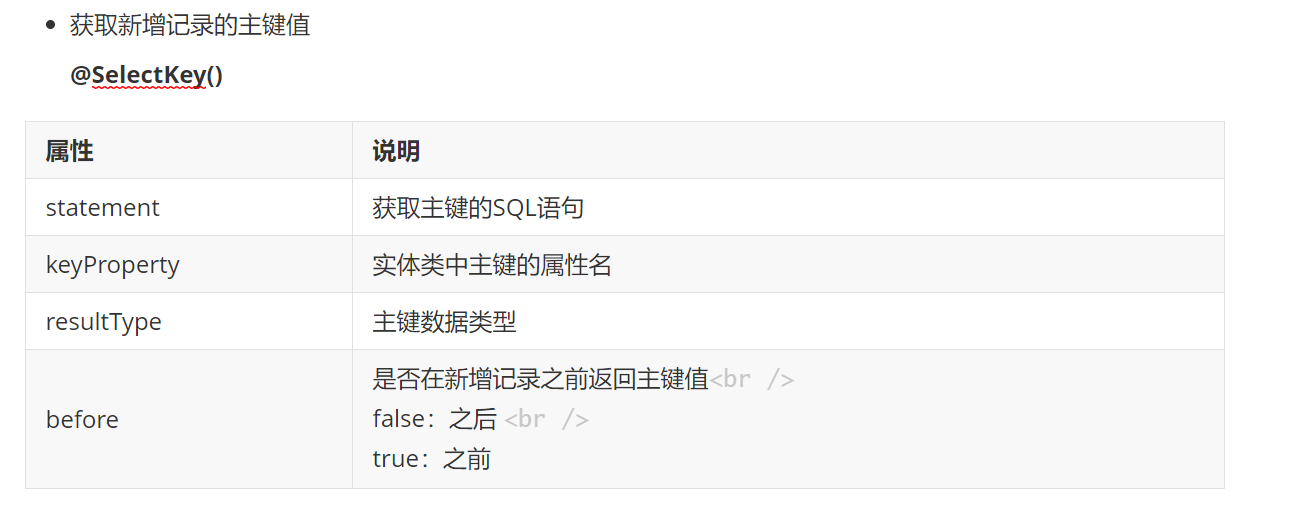
结果映射
@Results:
@Result
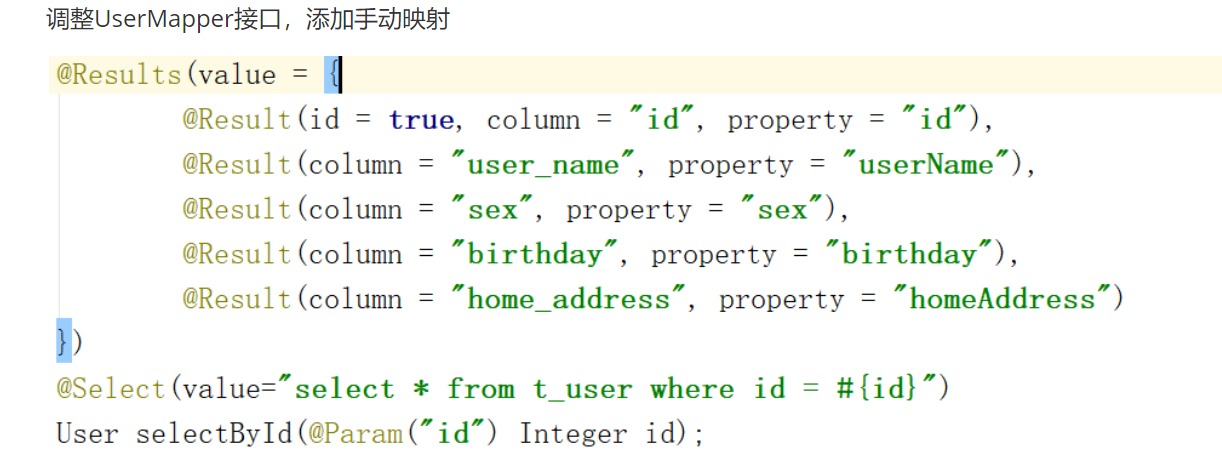
@Results:
含义:封装映射关系的父注解。
属性
value: 定义了Result 数组
@Result
含义:封装映射关系的子注解。
属性
id: 是否是主键
column:查询出的表中字段名称
property 属性:实体对象中的属性名称
javaType属性:被包含对象的数据类型
一对一级联查询
@One
@Results(value = {
@Result(id = true, column = "id", property = "id"),
@Result(column = "user_name", property = "userName"),
@Result(column = "sex", property = "sex"),
@Result(column = "birthday", property = "birthday"),
@Result(column = "home_address", property = "homeAddress"),
@Result(
property = "userInfo",
column = "id",
one = @One(select = "com.itheima.dao.UserInfoMapper.selectUserInfoByUserId"))
})
@Select(value="select * from t_user where id = #{id}")
User selectById(@Param("id") Integer id);
public interface UserInfoMapper {
@Select("select * from t_user_info where user_id = #{user_id}")
UserInfo selectUserInfoByUserId(Integer userId);
}
@Results : 映射结果集
@Result: 映射某一列
@One: 一对一映射
一对多级联查询
@Many: 一对多映射
@Results(value = {
@Result(id = true, column = "id", property = "id"),
@Result(column = "user_name", property = "userName"),
@Result(column = "sex", property = "sex"),
@Result(column = "birthday", property = "birthday"),
@Result(column = "home_address", property = "homeAddress"),
@Result(
property = "userInfo",
column = "id",
one = @One(select = "com.itheima.dao.UserInfoMapper.selectUserInfoByUserId")),
@Result(
property = "orders",
column = "id",
many = @Many(select = "com.itheima.dao.OrderMapper.selectOrderListByUserId"))
})
@Select(value="select * from t_user where id = #{id}")
User selectById(@Param("id") Integer id);
public interface UserInfoMapper {
@Select("select * from t_user_info where user_id = #{user_id}")
UserInfo selectUserInfoByUserId(Integer userId);
}
@Results : 映射结果集
@Result: 映射某一列
@Many: 一对多映射
原理
一级,二级缓存
MyBatis的缓存
@Transactional注解和Mybatis缓存问题
mybatis springboot 开启缓存
mybatis缓存分为 一级缓存和二级缓存
注:
缓存只针对于DQL语句,也就是说缓存机制只对应select语句。
在springboot中,使用了数据库连接池,默认每次查询后自动提交(commite),导致两次查询 不是一个sqlSession,根据一级缓存原理,它不会生效
缓存优先级: 二级>一级>数据库
1. ⼀级缓存:一级缓存的范围是SqlSession!
①⼀级缓存默认是开启的,不需要做任何配置。
②原理:只要使⽤同⼀个SqlSession对象执⾏同⼀条SQL语句,就会⾛缓存。
2. ⼆级缓存: ⼆级缓存的范围是SqlSessionFactory对象!
使⽤⼆级缓存需要具备以下⼏个条件:
① 全局性地开启或关闭所有映射器配置⽂件中已配置的任何缓存。默认就是true,⽆需设置(默认>二级缓存就是开启的)!
②在需要使⽤⼆级缓存的SqlMapper.xml⽂件中添加一个标签:
③使⽤⼆级缓存的实体类对象必须是可序列化的,也就是必须实现java.io.Serializable接⼝
④SqlSession对象关闭或提交之后,⼀级缓存中的数据才会被写⼊到⼆级缓存当中;此时⼆级缓存才可⽤。
3.MyBatis集成第三方缓存EhCache(了解)
集成EhCache是为了代替MyBatis⾃带的⼆级缓存,⼀级缓存是⽆法替代的!
懒加载
mybatisPlus
国内研发,在 MyBatis 的基础上只做增强不做改变
官网
依赖
<!--SpringBoot-->
<dependency>
<groupId>com.baomidou</groupId>
<!--下面坐标根据自己使用的SpringBoot版本二选一-->
<!--SpringBoot2使用此版本-->
<artifactId>mybatis-plus-boot-starter</artifactId>
<!--3.5.4开始,支持SpringBoot3使用此版本-->
<artifactId>mybatis-plus-spring-boot3-starter</artifactId>
<version>最新版本</version>
</dependency>
配置
mybatis-plus:
mapper-locations: classpath:net/cnki/editor/expense/dao/impl/*.xml
#类型:String[]
#默认值:["classpath*:/mapper/**/*.xml"]
#MyBatis Mapper 所对应的 XML 文件位置,如果您在 Mapper 中有自定义方法(XML 中有自定义实现),需要进行该配置,告诉 Mapper 所对应的 XML 文件位置,Maven 多模块项目的扫描路径需以 classpath*: 开头 (即加载多个 jar 包下的 XML 文件)
type-aliases-package: net.cnki.editor.expense.dos
#类型:String
#默认值:null
#MyBaits 别名包扫描路径,通过该属性可以给包中的类注册别名,注册后在 Mapper 对应的 XML 文件中可以直接使用类名,而不用使用全限定的类名(即 XML 中调用的时候不用包含包名)
configuration.map-underscore-to-camel-case: true
#类型:boolean
#默认值:true
#是否开启自动驼峰命名规则(camel case)映射,即从经典数据库列名 A_COLUMN(下划线命名) 到经典 Java 属性名 aColumn(驼峰命名) 的类似映射。
global-config.db-config.id-type: assign_id
# 类型:com.baomidou.mybatisplus.annotation.IdType
#默认值:ASSIGN_ID
#全局默认主键类型
注解
@MapperScan
在 Spring Boot 启动类中添加 @MapperScan 注解,扫描 Mapper 文件夹:
每天一个注解之@MapperScan
@SpringBootApplication
@MapperScan("com.baomidou.mybatisplus.samples.quickstart.mapper")
public class Application {
public static void main(String[] args) {
SpringApplication.run(Application.class, args);
}
}
@TableName
描述:表名注解,标识实体类对应的表
使用位置:实体类
@TableId
描述:主键注解
使用位置:实体类主键字段
@TableField(opens new window)
描述:字段注解(非主键)
使用
springboot整合
1.添加依赖
2.添加配置文件
3.添加启动类扫描
@SpringBootApplication
@MapperScan("com.winter.dao")
public class SpringbootMybatisDemoApplication {
public static void main(String[] args) {
SpringApplication.run(SpringbootMybatisDemoApplication.class, args);
}
}
4.添加实体类
@TableName("tb_user")
@Data
public class User {
//设置id生成策略:AUTO 数据库自增
@TableId(type = IdType.AUTO)
private Long id;
//@TableField("user_name")
private String userName;
private String password;
private String name;
private Integer age;
private String email;
//不希望该值存入数据库
// @TableField(exist = false)
// private String info;
}
5.创建mapper(可通过插件生成)
/**
* 使用mp定义Mapper,需要让Mapper接口继承 BaseMapper接口。
*/
public interface UserMapper extends BaseMapper<User> {
}
6.创建service
public interface _UserService extends IService<User> {
}
@Service
public class _UserServiceImpl extends ServiceImpl<UserMapper, User> implements _UserService {}
7.分页查询,添加分页拦截器
@Configuration
public class PageConfig {
/**
* 3.4.0之前的版本用这个
* @return
*/
/* @Bean
public PaginationInterceptor paginationInterceptor(){
return new PaginationInterceptor();
}*/
/**
* 3.4.0之后提供的拦截器的配置方式
* @return
*/
@Bean
public MybatisPlusInterceptor mybatisPlusInterceptor(){
MybatisPlusInterceptor mybatisPlusInterceptor = new MybatisPlusInterceptor();
mybatisPlusInterceptor.addInnerInterceptor(new PaginationInnerInterceptor());
return mybatisPlusInterceptor;
}
}
/**
* 分页查询:
* 1. 当前页码:currentPage
* 2. 每页显示条数:size
*
* 注意:使用mp的分页要设置一个拦截器!!!
*/
@Test
public void testSelectPage() {
int current = 1;//当前页码
int size = 2;//每页显示条数
IPage<User> page = new Page(current,size);
userMapper.selectPage(page,null);
List<User> records = page.getRecords();//当前页的数据
long pages = page.getPages();//总页数 2
long total = page.getTotal();//总记录数 4
System.out.println(records);
System.out.println(pages);
System.out.println(total);
}
8.条件构造器
基础比较查询
Wrapper()包装器://条件构建器
1.QueryWrapper
LambdaQueryWrapper
2.UpdateWrapper
LambdaUpdateWrapper
方法:
eq( ) : 等于 =
ne( ) : 不等于 <>
gt( ) : 大于 >
ge( ) : 大于等于 >=
lt( ) : 小于 <
le( ) : 小于等于 <=
between ( ) : BETWEEN 值1 AND 值2
notBetween ( ) : NOT BETWEEN 值1 AND 值2
in( ) : in
notIn( ) :not in
逻辑查询
or( ) :让紧接着下一个方法用or连接
模糊查询
like 查询关键字前后都加%
notLike
likeLeft
likeRight
排序查询
orderBy
orderByAsc通过某个条件正排
orderByDesc反排
select:指定需要查询的字段
@Test
public void testWrapper2(){
//1.创建查询条件构建器
QueryWrapper<User> wrapper = new QueryWrapper<>();
//2.设置条件
wrapper.eq("user_name","lisi")
.or()
.lt("age",23)
.in("name","李四","王五");
/*
select * from tb_user where user_name = ? or age < ? and name in (?,?)
*/
List<User> users = userMapper.selectList(wrapper);
System.out.println(users);
}
LambdaQueryWrapper:消除代码中的硬编码
@Test
public void testWrapper7(){
LambdaQueryWrapper<User> wrapper = new LambdaQueryWrapper<>();
wrapper.eq(User::getUserName,"zhangsan");
userMapper.selectOne(wrapper);
}
LambdaQueryWrapper原理
代码生成工具,IDE插件






















 1008
1008

 被折叠的 条评论
为什么被折叠?
被折叠的 条评论
为什么被折叠?








